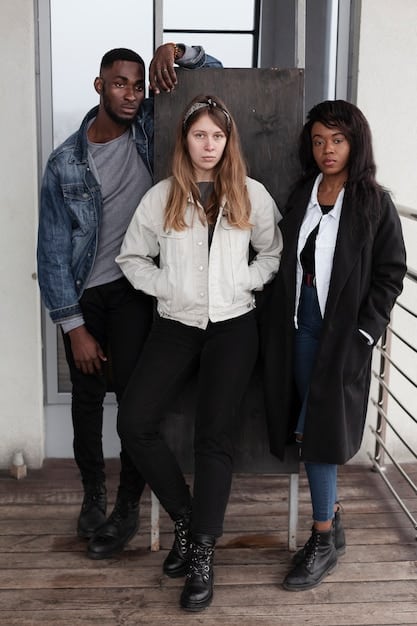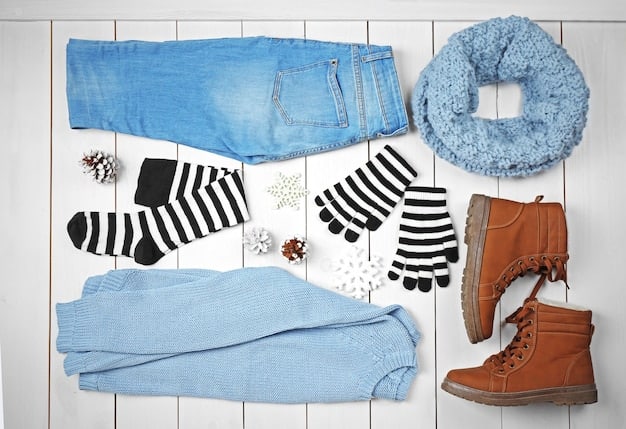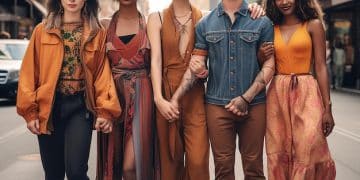Instagram Style Mythbusters: Debunking Fashion Myths

This article delves into the “Instagram Style Mythbusters: Debunking Common Misconceptions About Fashion” by exposing pervasive but often misleading notions about digital fashion, offering a nuanced perspective beyond the curated feeds, and advocating for a more authentic and sustainable approach to personal style in the digital age.
In a world increasingly shaped by digital aesthetics, the concept of “Instagram Style” has emerged as a dominant force, influencing how we perceive fashion and personal expression. Yet, beneath the veneer of perfectly curated feeds and aspirational imagery lies a complex web of assumptions and untruths. This article aims to act as the ultimate Instagram Style Mythbusters: Debunking Common Misconceptions About Fashion, challenging prevalent notions and offering a more grounded perspective on what it truly means to be stylish in the digital age.
The Illusion of Effortless Perfection: Beyond the Filter
The quest for perceived effortless perfection on Instagram often leads to a misrepresentation of reality in fashion. What appears spontaneous and natural is frequently the result of meticulous planning, strategic posing, and often, extensive digital editing. This curated façade can impose unrealistic expectations on individuals, promoting a belief that true style is synonymous with flawlessness and constant newness.
Understanding the layers behind these seemingly perfect images is crucial for developing a healthier relationship with fashion and social media. It’s not about criticizing creativity or artistic expression, but rather recognizing the construction inherent in seemingly effortless visuals.
The Reality of Photoshoots
Behind every “candid” street style shot or perfectly arranged flat lay lies a process that often mimics professional photoshohoots. This includes multiple takes, specific lighting setups, and even changes in location. The goal is to capture the ideal moment, which in reality, is often a fabricated one.
- Strategic Posing: Models and influencers meticulously practice poses to flatter their figures and showcase outfits effectively, a skill that takes time to master.
- Lighting is Key: Natural light, golden hour, or professional lighting equipment are often utilized to enhance colors and textures, creating a more appealing visual.
- Multiple Takes: A single “perfect” shot might be selected from dozens or even hundreds of attempts, highlighting the effort involved.
The Role of Digital Editing
Beyond the camera, digital editing tools play a significant role in refining Instagram style. From color correction and skin smoothing to background alterations and body contouring, these tools transform raw images into their polished final versions. This level of manipulation further removes the image from reality, creating a digital ideal that is unattainable in everyday life.
The pursuit of perfection, fueled by these tools, inadvertently perpetuates a cycle where individuals feel compelled to present an unrealistic version of themselves. This can impact self-esteem and lead to a skewed perception of beauty and fashion norms.
Ultimately, the “effortless perfection” seen on Instagram is a carefully constructed illusion. Recognizing this helps in appreciating the artistry involved while simultaneously fostering a more realistic and self-compassionate view of personal style. True style, after all, thrives on authenticity, not on unattainable digital ideals.
Myth 1: You Need to Buy New Clothes Constantly to Be Stylish
One of the most persistent myths propagated by Instagram culture is the notion that staying stylish inherently requires a constant influx of new clothing. The relentless cycle of “hauls” and “OOTDs” (Outfit Of The Day) often showcases a seemingly endless wardrobe, implying that novelty is synonymous with fashion relevance. However, this belief not only strains personal finances but also contributes significantly to environmental unsustainability. True style is not about the quantity or newness of one’s garments, but rather how thoughtfully they are combined and worn.
The Sustainability Imperative
Fast fashion’s business model, heavily supported by social media trends, encourages rapid consumption. Clothes are produced cheaply and quickly, often in unethical conditions, leading to immense waste. The idea that new pieces are constantly needed ignores the environmental impact of textile production, from excessive water usage and pesticide application to microplastic pollution from synthetic fabrics. Embracing a more sustainable approach involves challenging this consumerist mindset.
- Reduce, Reuse, Recycle: Prioritizing these principles in fashion choices can drastically reduce one’s environmental footprint.
- Quality Over Quantity: Investing in well-made, durable pieces reduces the need for frequent replacements.
- Thrift and Second-Hand: Exploring pre-loved clothing provides unique finds and extends the life of garments, diverting them from landfills.
The Art of Rewearing and Styling
Instead of constantly acquiring new items, truly stylish individuals understand the power of re-wearing and creative styling. A versatile wardrobe, built on foundational pieces and complemented by carefully selected accessories, allows for endless outfit combinations. The challenge and joy lie in transforming existing garments through different pairings, layering, and accessorizing. This approach encourages creativity and personal expression, moving away from a uniform, trend-driven aesthetic.
By debunking the myth of constant consumption, we empower individuals to cultivate a personal style that is both authentic and environmentally conscious. It shifts the focus from chasing fleeting trends to building a wardrobe that genuinely reflects one’s individuality and values, fostering a deeper appreciation for what one already owns.
Myth 2: Designer Labels Are Essential for a Chic Look
The pervasive presence of designer labels on Instagram feeds often creates the misconception that a chic or sophisticated look is unattainable without luxury brands. Influencers showcasing high-end bags, shoes, and clothing can inadvertently set a benchmark, leading many to believe that expensive items are prerequisites for fashion credibility. However, genuine style transcends price tags and brand names; it is rooted in understanding fit, fabric, and personal aesthetic rather than adhering to perceived status symbols.
The Power of Fit and Fabrication
Regardless of whether a garment is high-end or budget-friendly, its fit and fabrication are paramount to how it looks and feels. A well-tailored piece from an affordable brand can often appear far more polished than an ill-fitting designer item. Understanding one’s body shape and opting for clothes that complement it is a foundational principle of good style. Similarly, attention to fabric composition—choosing natural fibers or well-made synthetics—can significantly elevate an outfit, offering comfort and longevity that often surpass trendy, low-quality alternatives.
Focusing on these elements allows individuals to build a versatile and elegant wardrobe without breaking the bank. It’s about discerning quality and flattering silhouettes, rather than chasing logos.
Curating a High-Low Wardrobe
Many fashion-savvy individuals and stylists advocate for a “high-low” approach, masterfully blending affordable pieces with a few select high-quality or designer items. This strategy maximizes versatility and allows for personal expression without the pressure of a fully designer wardrobe. A statement accessory, like a well-structured handbag or a classic watch, can elevate an entire ensemble, demonstrating that impactful style isn’t about head-to-toe luxury.
- Strategic Investment: Identify key pieces worth splurging on, such as versatile outerwear or classic shoes, that will stand the test of time.
- Elevate Basics: Transform simple basics by pairing them with a statement accessory or by focusing on impeccable fit.
- Thrift Store Gems: Discover unique, high-quality items at second-hand shops, proving that style has no price tag.
Ultimately, the myth that designer labels are essential for a chic look crumbles under scrutiny. True style emanates from confidence, an understanding of one’s body, and the ability to combine pieces harmoniously, regardless of their origin or cost. It is about personal artistry, not brand caché.

Myth 3: You Must Follow All Trends to Be Fashionable
Instagram’s rapid-fire trend cycle often creates the illusion that one must constantly adopt the latest fads to remain fashionable and relevant. From viral aesthetic shifts to fleeting garment styles, the platform bombards users with new “must-haves,” leading to a fear of being “out of style.” However, chasing every trend is not only impractical but can also dilute personal expression. True fashionability lies in understanding which trends genuinely align with one’s personal style and adapting them thoughtfully, rather than blindly adhering to every prevailing wave.
Fast Fashion’s Influence on Trends
The acceleration of trends is heavily influenced by fast fashion retailers, who quickly replicate runway or high-fashion looks at accessible price points. This rapid production cycle, amplified by social media’s instantaneous dissemination of images, encourages rapid consumption and discards. The result is a perpetual sense of urgency to update one’s wardrobe, often leading to purchases that are quickly regretted and discarded, contributing to textile waste.
Resisting this pressure allows individuals to develop a more conscious approach to fashion, focusing on longevity and personal resonance over fleeting popularity. It’s about building a wardrobe that serves you, not one that dictates your self-expression.
Cultivating Timeless Style with Trend Touches
Instead of becoming a slave to trends, truly stylish individuals understand the value of a timeless wardrobe, composed of classic pieces that endure across seasons and years. These foundational items can then be updated and personalized with judiciously chosen trend-driven accessories or a single, impactful garment. This approach allows for a fresh look without overhauling an entire closet every few months. It’s about selective incorporation, not wholesale adoption.
- Identify Your Core Style: Understand your preferred silhouettes, colors, and textures to build a solid foundation.
- Selective Trend Adoption: Pick one or two trends that genuinely appeal to you and integrate them subtly into your existing wardrobe.
- Accessorize Wisely: Accessories like scarves, belts, or jewelry can instantly update an outfit without major investment or commitment.
The myth that relentless trend-following is a prerequisite for fashionability is a fallacy. Authentic style is built on self-awareness, smart choices, and the confidence to walk your own path, incorporating elements that genuinely reflect who you are, rather than what social media dictates.
Myth 4: Instagram Style Is Exclusively for a Certain Body Type or Age
A significant misconception perpetuated by certain segments of Instagram’s fashion community is that “Instagram style” is exclusively attainable for a narrow range of body types—typically thin, tall, and young. This often results from the algorithms highlighting content that fits conventional beauty standards, inadvertently sidelining diverse representations. This exclusivity is a fallacy, as style is inherently personal and universally accessible, transcending age, size, and physical attributes. Fashion is about self-expression, and every individual, regardless of their body, can cultivate a compelling aesthetic.
Challenging Conventional Beauty Standards
The narrow representation of body types on some mainstream fashion accounts can be detrimental, leading to feelings of inadequacy and exclusion among those who don’t fit the mold. However, a growing movement of body positivity and inclusivity on Instagram actively challenges these norms, demonstrating that style flourishes in diversity. Many content creators are championing authentic representation, showcasing how fashion can be adapted and celebrated on all body shapes and sizes.
Embracing a broader definition of style encourages creativity and fosters a more welcoming and empowering fashion landscape. It celebrates the individual over an idealized, often unrealistic, standard.
Age and Style: A Timeless Connection
Similarly, the notion that Instagram style is primarily the domain of youth is rapidly being debunked. Many influential accounts are led by older individuals who showcase sophisticated, contemporary, and often avant-garde fashion choices, proving that age is no barrier to being fashionable and inspiring. Style evolves with life experience, and mature individuals often possess a deeper understanding of what truly suits them, leading to a more refined and confident aesthetic.
- Focus on Self-Confidence: The most stylish individuals radiate confidence, regardless of their age or size.
- Adapt Trends: Trends can be adapted to suit any body type or age through clever styling and thoughtful selection.
- Seek Diverse Inspiration: Actively follow accounts that represent a wide range of body types and age groups to broaden your perspective.
The myth that Instagram style is exclusive to certain demographics is a relic of outdated thinking. Fashion is a form of artistic expression, and like any art, it knows no boundaries of demographics. It is a tool for empowerment and self-love, accessible to everyone willing to explore and define their unique aesthetic.
Myth 5: Authenticity Doesn’t Matter on Instagram
In the highly curated world of Instagram, there’s a prevalent underlying myth that authenticity takes a backseat to aesthetics. The pressure to present a flawless, aspirational image can lead to content creators and users prioritizing perfection over genuine expression, fostering a sense of disconnect between what is shown and what is real. However, sustained engagement and true influence are increasingly built on authenticity and relatability, proving that transparency and genuine self-expression resonate deeply with audiences.
The Rise of Relatability
While polished visuals initially draw attention, it’s relatability that cultivates a loyal following. Audiences are increasingly seeking out creators who share their struggles, document their imperfections, and showcase their true personalities. This shift reflects a growing fatigue with overly manufactured content and a desire for more human connection online. Authenticity builds trust, and trust is the foundation of any meaningful relationship, whether personal or digital.
Creators who are open about their processes, challenges, and unglamorous moments often find a more engaged and sympathetic audience. This move towards authenticity challenges the notion that every post must be a perfect performance.
Behind-the-Scenes and Imperfect Moments
The current trend on Instagram leans towards showcasing more “behind-the-scenes” content, unedited moments, and real-life scenarios. This includes glimpses into the creative process, candid everyday outfits, or even sharing styling mishaps. These imperfect moments allow audiences to connect on a deeper level, recognizing the shared human experience beyond the filtered facade. It reinforces the idea that true style is a journey, not a destination, complete with its trials and errors.
- Share the Process: Show how you put outfits together, even if it’s not always perfect.
- Embrace Vulnerability: Discuss fashion challenges, ethical dilemmas, or personal style evolutions.
- Interact Genuinely: Engage with your audience in a way that feels organic and conversations, not just promotional.
The myth that authenticity doesn’t matter on Instagram is steadily being debunked by a growing demand for genuine content. As users become more discerning, the value of realness, relatability, and transparency in fashion content creation has become undeniable. True influence stems from genuine connection, and that connection is forged through authenticity.

| Key Point | Brief Description |
|---|---|
| ✨ Effortless Illusion | Instagram’s “effortless” looks are often highly curated and edited, setting unrealistic standards. |
| ♻️ Sustainable Style | Constant new purchases are unnecessary; re-wearing and styling existing clothes is key to sustainable fashion. |
| 🏷️ Labels vs. Look | Designer labels aren’t essential; fit, fabric, and personal aesthetic define a chic look. |
| 💖 Authentic Appeal | Authenticity and relatability increasingly drive engagement on Instagram, trumping pure aesthetics. |
Frequently Asked Questions About Instagram Style
▼
Not entirely. While Instagram showcases trends and inspirations, much of the “style” presented is highly curated and edited. It often reflects aspirational imagery rather than the practicalities of daily wear, sometimes leading to a skewed perception of what’s achievable or necessary for genuine style.
▼
Absolutely not. Many stylish individuals on Instagram achieve great looks using a mix of high-street brands, vintage finds, and carefully chosen key pieces. Emphasis on fit, quality textiles, and creative styling matters far more than the price tag or brand name of items. Sustainability also encourages a focus on what you already own.
▼
While trends are visible on Instagram, blindly following every new fad is not crucial for good style. Authentic style integrates trends selectively and thoughtfully, choosing those that align with personal taste and existing wardrobe. A timeless, versatile wardrobe with a few on-trend accessories often creates a more enduring and personal aesthetic.
▼
Yes, increasingly so. Although some initial portrayals were narrow, a growing movement on Instagram celebrates diversity in body types, ages, and backgrounds within fashion. Many creators are championing inclusivity, proving that genuine style knows no boundaries and can be expressed beautifully by anyone, regardless of their physical attributes.
▼
Yes, authenticity is becoming highly valued. While curation remains, there’s a growing demand for relatability and transparency. Audiences are increasingly connecting with creators who show more behind-the-scenes content, imperfections, and genuine personality, building trust and deeper engagement beyond mere aesthetic appeal.
Conclusion
The landscape of “Instagram Style” is undeniably influential, yet it’s imperative to approach it with a discerning eye. By debunking common misconceptions—from the illusion of effortless perfection and the necessity of constant new purchases to the perceived exclusivity of designer labels and narrow body type ideals—we can cultivate a healthier, more authentic relationship with fashion. True style, whether online or offline, thrives on individuality, thoughtful choices, and confidence, rather than adherence to a digital façade. Embracing sustainability, personal expression, and genuine connection will ultimately lead to a more fulfilling and impactful fashion journey for everyone.





